

Rick surveys internet-edge devices including next-generation set-top boxes, server devices and wireless access points.
Ask a sampling of embedded Linux vendors what they think the most likely embedded Linux “killer apps” are, and you'll probably end up with a list similar to this:
Telecommunications infrastructure (high-availability, carrier-grade systems).
Handheld mobile devices (including PDAs and smart phones).
Wireless access points (for public 802.11 or Bluetooth WLAN access).
Digital set-top boxes (digital TV, video and audio systems).
Server devices (offering easy-to-use LAN-server/firewall/gateway/router/VPN functions).
Since the last three in this list—wireless access points, set-top boxes and server devices—are all small appliance-like “black boxes” that sit on the edge of the Internet and provide access to internet-based services and resources, let's combine those last three into one and call it “internet-edge devices”. That simplifies the list into three categories of embedded Linux killer apps: 1) telecommunications infrastructure, 2) handheld mobile devices and 3) internet-edge devices.
I've already covered the first of these in this column a few months back (see “Embedded Linux Targets Telecom Infrastructure” in the May 2002 issue of Linux Journal). The growing support for Linux in this space from telecom equipment heavyweights HP, IBM, Motorola and Sun Microsystems leaves little doubt that Linux is going to have a bright future in the telecom equipment market—when the telecom market finally takes off, that is.
As for the use of embedded Linux in PDAs and other handhelds, success may well hinge on Sharp's Zaurus, the first such device to be strongly promoted by a world leader in consumer electronics. With the Zaurus just starting to make it into retail channels, it's too early to predict whether the Zaurus and its Linux-based software stack are going to be long-term winners. Rumors abound of ongoing projects to develop Linux-based PDAs and smart phones, particularly in Asia, so we can expect to see five to ten such devices hit the market during the latter half of 2002.
So far, embedded Linux has not fared well in the handheld mobile device market, with many projects being canceled and some resulting in stillborn products. Microsoft's Pocket PC, on the other hand, has grown steadily in market share at PalmOS' expense. Is it too late for embedded Linux in the handhelds market? The next six to nine months will answer that question.
This brings us to the third killer app category: internet-edge devices. Think of these as highly compact, web-enabled server appliances having a variety of application-specific task assignments. Given the unquestioned success of Linux in the server space, coupled with the proven capability of Linux to satisfy the tight resource constraints of embedded devices, it should come as no surprise that Linux is likely to be a big winner in this important emerging class of products.
Let's take a look at some products in the internet-edge devices category that use embedded Linux as their internal OS platform.
This class of devices spans a wide range of capabilities, including such functions as personal video recorder functions, video-on-demand, e-mail and web access, and streaming video and audio media storage and playback. Here are a few embedded Linux-based examples:
TiVo Personal TV: need I say more?
Nokia Mediaterminal: this device adds a broad range of internet-based services to a normal TV set. Among the services available are digital audio/video, digital TV, video-on-demand, cached TV programs, web access, e-mail and chatting, games/gaming and many web-based software applications. The Mediaterminal's internal software is based on Linux, the Mozilla open-source browser, the X Window System, plus a unique user-interface technology called Nokia Navi bars. The embedded computer is a 366MHz Intel Celeron CPU along with the Intel 810 chipset, plus 32MB SDRAM and a minimum 20GB hard disk. (See www.nokia.com/multimedia/mediaterminal.html.)
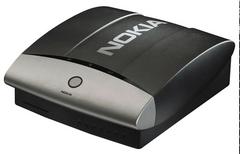
Nokia Mediaterminal
ZapMedia ZapStation: ZapMedia's first product is a Linux-powered audio/video jukebox for serious consumer audiophiles. Beneath that stereo receiver look-and-feel lurks an 800MHz Intel Celeron equipped with 128MB RAM and a 30GB hard drive, running Linux kernel 2.4. The GUI is based on XFree86, Qt, Java and a customized Fresco Browser. (See www.zapmedia.com.)

ZapMedia ZapStation
HP Digital Entertainment Center: HP's first product in the consumer entertainment device space has Linux 2.4 and the X Window System inside. Its embedded computer is based on a 566MHz Celeron, with 64MB RAM and a 40GB hard disk, and its interfaces include USB, Ethernet, HPNA, a built-in V.90 modem, stereo audio and video out for display on a TV. The device can download and record music and videos from the Internet and can read and copy music CDs onto its internal hard drive. (See products.hp-at-home.com.)
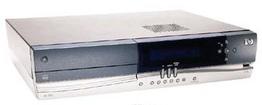
HP Digital Entertainment Center
Bokks Portable Media Player: this versatile device connects to a broadband network via DSL, cable or optical fiber and plugs in to a TV to allow e-mail and internet access. It stores movies, music and other files on its internal multi-gigabyte hard drive, allowing them to be listened to or viewed whenever the user is near a TV, stereo or computer and is based on a 266MHz National Semiconductor SC1200 system-on-chip processor running Linux kernel 2.4.x. (See www.bokks.net.)

Bokks Portable Media Player
Motorola DCT5000: Lineo announced that Motorola's Broadband Communications division had selected Lineo's Embedix for use in its interactive digital multimedia set-top appliances. The device includes features such as personal video recording, streaming media and home networking capabilities. (See www.linuxdevices.com/news/NS3134551333.)

Motorola DCT5000
JCC iBOX-2: Japan Computer Corporation (JCC) announced the development of a new internet appliance based on National's Geode “set-top box on a chip”, running an embedded Linux operating system. The device contains 16-32MB DRAM, an 8MB DiskOnChip Flash disk and has a built-in Ethernet port. (See www.linuxdevices.com/news/NS4653311319.)

JCC iBOX-2
VT Media VT-100: VT Media Technologies is partnering with Century Embedded Software to push into the low-cost broadband/IP set-top box market with a Linux-based solution. At CeBIT 2002, VT Media announced what they claim is the world's first broadband set-top box with a price point below $150 US. The device is based on National Semiconductor's x86-based STB reference design along with Century's WebMedia software stack and Linux port. (See www.vtmt.com and www.censoft.com.)

VT Media VT-100
These devices are appliance-like “black boxes” used in home, small office and workgroup environments that are used as local servers (for local networking and file/printer sharing) or internet gateways (firewall, router, e-mail server, VPN, etc.). With a built-in Linux OS and open-source web server, these gadgets often provide point-and-click, browser-based setup and configuration by nontechnical users, and are unburdened by the high costs of proprietary software licenses. Here are a few embedded Linux-based examples:
Filanet InterJak: the maker of this easy-to-use Linux-based appliance says it offers a Swiss Army Knife's worth of solutions to today's wired citizen. Inside, there's an x86 processor with 128MB of RAM, a multi-gigabyte hard disk, plus Linux and a host of other open-source software including Apache, MySQL and the Exim mail server. (See www.filanet.com.)

Filanet InterJak
SnapGear VPN Routers: this family of compact, easy-to-configure, Linux-based devices offer gateway, router, firewall and VPN services. The low-end versions are based on Motorola ColdFire processors with 4-8MB of RAM and 1-2MB of Flash, while the high-end ones are powered by AMD SC520 processors with up to 128MB of RAM and 16MB of Flash. SnapGear makes extensive use of µClinux and is a contributor to the source tree. (See www.snapgear.com.)
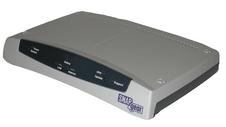
SnapGear VPN Router
Celestix Networks Aries: this compact appliance-like system is designed for easy-to-use resource sharing and internet access within small workgroups of up to 50 users. It makes use of laptop-style components and embedded Linux, resulting in reliable, fanless operation and a small enclosure footprint. (See www.celestix.com.)
Sun Cobalt Cube: described as “a complete Internet and intranet server in a box”, the Cobalt Cube combines server, gateway, router and VPN functions in an easy-to-configure, appliance-like blue box. The device is powered by embedded Linux running on an AMD K6-II CPU, equipped with up to 512MB of SDRAM and a high-capacity SCSI hard drive, plus interfaces for 10/100 Mbit Ethernet, serial console and USB. (See www.cobalt.com.)
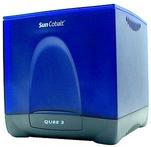
Sun Cobalt Cube
emWare DeviceGate: a highly compact yet fully functioning Linux-based gateway for specialized applications. Contains either a 486 or PowerPC processor, with 16MB system RAM and a 16MB DiskOnChip solid-state disk, plus interfaces for Ethernet and RS-232/485 serial. One example application of this device is remotely monitoring industrial pump controllers to help maintain water quality in water treatment plants. (See www.emware.com.)
These small appliance-like devices provide 802.11 or Bluetooth wireless networking “hot spots” or “hot zones” in companies, shopping centers, libraries, downtown areas, airports, coffee shops and other public locations. Here are a few embedded Linux-based examples:
Axis “Bluetooth Hot Spot”: the model 9010 Access Point is based on the Axis ETRAX 32-bit RISC system-on-chip processor, equipped with 16MB DRAM and 2MB Flash memory, a built-in Bluetooth transceiver and a 10/100 Mbit Ethernet interface. The device's embedded software consists of Axis' ETRAX µClinux port along with an Axis-developed Bluetooth Linux stack, plus a built-in web server for easy web-based installation and maintenance. (See www.axis.com/products/axis_9010.)
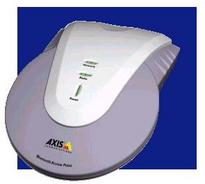
Axis Bluetooth Hotspot
Ericsson's “BLIP”: the BLIP is a small, self-contained device that communicates wirelessly with mobile phones, PDAs and other kinds of mobile devices that are equipped with Bluetooth short-range wireless technology. Inside the BLIP is an ARM7TDMI-based 32-bit RISC processor with 2MB RAM and 2MB Flash, running µClinux, µClibc and Ericsson's Bluetooth Host Stack. The first version of the BLIP (BLIP C11) is no longer available and will be replaced by a new version (BLIP Net) later this year, according to a manager from Ericsson's Business Innovation group. (See www.linuxdevices.com/articles/AT9037120829.)
Wireless Networks' BlueLAN: this device is built around NetSilicon's 32-bit ARM7TDMI RISC system-on-chip processor running µClinux. Its interfaces include a serial port, 10/100 Mbit Ethernet and a built-in Bluetooth V1.1 transceiver. (See www.wirelessnetworksinc.com/prod_bluelan.htm.)
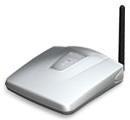
Wireless Networks BlueLAN
Musenki M-1/M-3: this recently announced family of access points is based on 200-333MHz Motorola MPC8241 system-on-chip processors, with up to 128MB SDRAM and 16MB Flash memory. The presence of internal Mini PCI slots offers a great deal of flexibility, such as the use of alternate versions of 802.11 or Bluetooth radios, as well as the addition of other desired functions and interfaces. Musenki took advantage of numerous open-source projects in creating their own unique embedded Linux implementation, including PenguinPPC kernel sources, PPCBoot, µClibc, BusyBox and more. (See www.musenki.com.)
Where and when will the greatest successes of embedded Linux emerge? What will be the highest volume products? Unfortunately, many killer app projects are kept under wraps until they're ready to hit the market, so we won't know about some of the most exciting ones until they make it to production. Watch this column for more news and perspective on this subject.
The following embedded Linux specialists contributed to this article: Lineo, Inc. (www.lineo.com), MontaVista Software (www.mvista.com) and TimeSys Corp. (www.timesys.com).
For the latest scoop (and details) on these and other devices with embedded Linux inside, visit LinuxDevices.com's “Embedded Linux 'Cool Devices' Quick Reference Guide” regularly (www.linuxdevices.com/articles/AT4936596231).